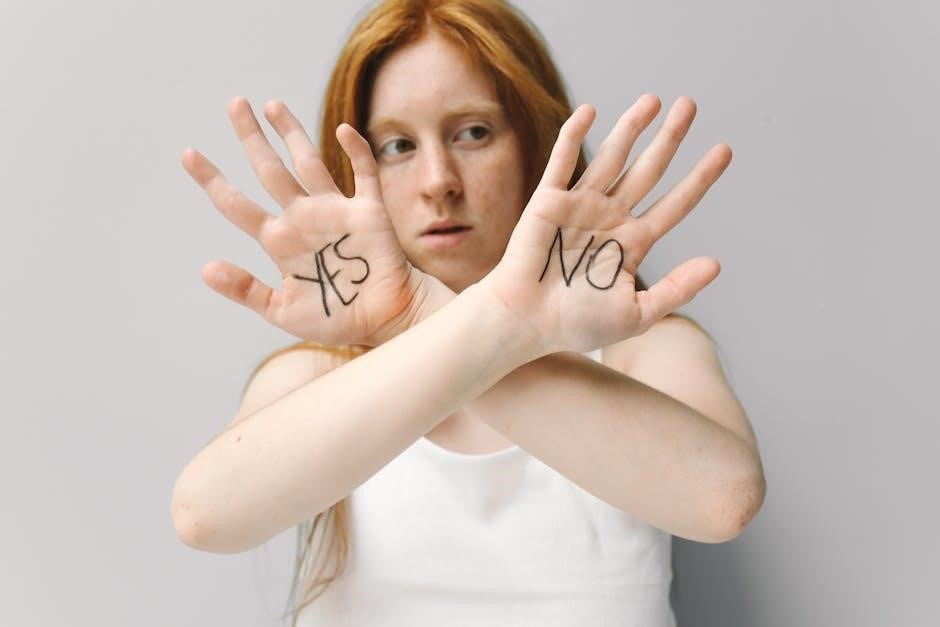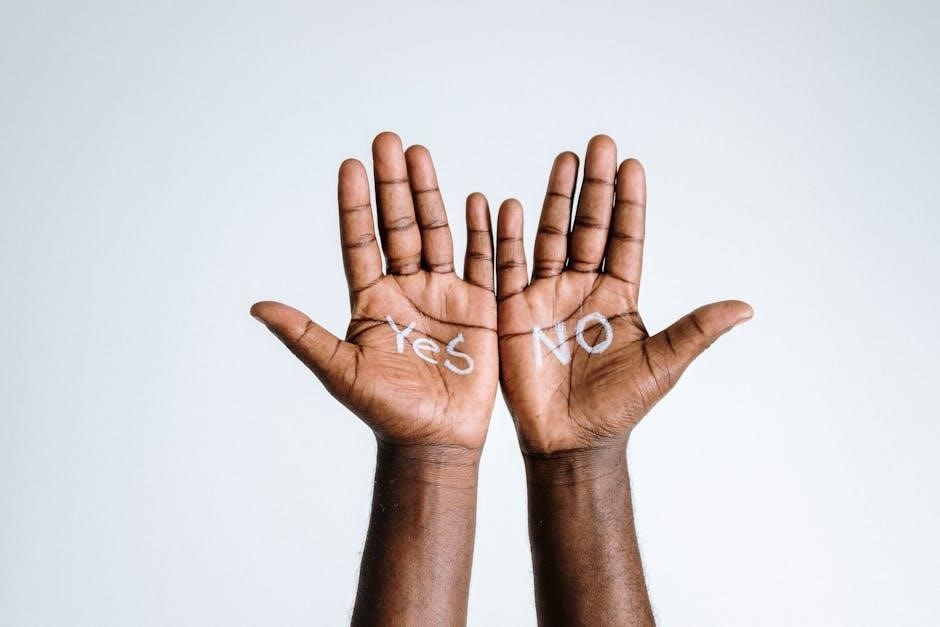The Yes/No/Maybe List is a powerful tool for open communication about sexual preferences, boundaries, and interests, fostering mutual respect and understanding in intimate relationships.
Overview of the Yes/No/Maybe List
The Yes/No/Maybe List is a detailed tool designed to help individuals and partners communicate their sexual preferences, boundaries, and interests clearly. It categorizes activities into three options: Yes (willing to try), No (not willing), and Maybe (open under certain conditions). This list covers a wide range of activities, from physical to non-physical, and even fetish-related, ensuring comprehensive exploration. It fosters open and judgment-free conversations, allowing partners to understand each other’s desires and limits. The list is user-friendly, often available in PDF formats, and can be customized to suit individual or shared preferences. Its purpose is to promote mutual respect, clarity, and excitement in relationships, making it an invaluable resource for those seeking to deepen intimacy and understanding.
Importance of Communicating Boundaries
Communicating boundaries is essential for fostering trust, respect, and clarity in any relationship. Using the Yes/No/Maybe List ensures that both partners openly express their comfort levels and desires, preventing misunderstandings and potential discomfort. By clearly defining personal limits, individuals can feel safe and empowered to explore their intimacy without fear of overstepping. This open dialogue also promotes mutual understanding, reducing anxiety and enhancing emotional connection. Respecting each other’s boundaries strengthens the foundation of trust, which is crucial for a healthy and fulfilling relationship. The list serves as a proactive way to address preferences and concerns, ensuring that both partners are on the same page. This clear communication fosters a positive environment for intimacy, where both individuals feel valued and respected. It’s a simple yet powerful tool for building a stronger, more understanding partnership.
How the List Helps in Relationships
The Yes/No/Maybe List plays a vital role in fostering open communication and mutual respect in relationships. By clearly outlining boundaries and preferences, it helps partners avoid misunderstandings and ensures both individuals feel heard and valued. This tool encourages honest dialogue about desires and comfort levels, creating a safe space for exploration. It also helps identify common interests while respecting differences, which strengthens emotional intimacy. The list acts as a guide for navigating intimacy with confidence, ensuring that both partners are comfortable and consenting. This openness fosters trust and understanding, which are essential for building and maintaining a healthy, fulfilling relationship. By using the list, couples can explore their preferences together, leading to deeper connections and more satisfying experiences. It’s a practical way to ensure both partners feel respected and prioritized in their relationship.

Understanding the Structure of the List
The Yes/No/Maybe List is organized into categories for Yes, No, and Maybe responses, covering physical, non-physical, and fetish-related activities. This structure provides clarity and ease of use for open discussions.
A Yes/No/Maybe List is a detailed tool designed to help individuals and partners communicate their sexual preferences, boundaries, and interests clearly. It categorizes activities into three sections: Yes for things one is willing to try, No for activities they are uncomfortable with, and Maybe for those they are unsure about or open to under specific conditions. This list serves as a platform for open and honest conversations, ensuring both partners understand each other’s desires and limits. It is often used in relationships to foster trust, respect, and mutual understanding, particularly in exploring new experiences together. The list can be customized to suit individual preferences and is a practical resource for navigating intimate discussions without judgment. The Yes/No/Maybe List is organized into categories to simplify communication. Physical activities may include kissing, holding hands, or intimate touching. Non-physical activities could involve verbal affection, role-playing, or watching erotic content. Fetish-related activities might cover BDSM, bondage, or specific kinks. Each category helps individuals classify their comfort levels. For example, a “Yes” for cuddling, “No” for public displays of affection, and “Maybe” for exploring new experiences under certain conditions. This structure ensures clarity and ease of discussion, allowing partners to understand each other’s boundaries and interests effectively. The list is customizable, making it adaptable to diverse preferences and needs. To fill out the Yes/No/Maybe list, start by obtaining the PDF version, which often includes pre-listed activities across categories like physical, non-physical, and fetish-related. Review each activity and mark “Yes” if you’re comfortable, “No” if you’re not, and “Maybe” if you’re undecided or open under certain conditions. Consider adding personal notes or conditions next to “Maybe” items to clarify your boundaries. It’s advisable to complete the list individually first, then discuss it with your partner to compare responses and address any differences. Be honest and open during discussions, and remember the list is not static—update it as preferences evolve. Regular reviews ensure ongoing communication and comfort, fostering a healthy relationship. Start with a Yes/No/Maybe list PDF template, reflecting on your comfort levels and preferences. Customize it by adding or removing activities to suit your needs, ensuring it aligns with your boundaries and desires. This personalized approach helps create open and respectful communication in your relationship. Creating a personalized Yes/No/Maybe List begins with reflection. Start by evaluating your comfort levels, desires, and boundaries regarding various activities. Use a Yes/No/Maybe List PDF template as a foundation, then tailor it to suit your preferences. For each activity, categorize it as Yes (comfortable and willing), No (not willing), or Maybe (open under specific conditions). Be honest and specific, adding personal notes or conditions where needed. Discuss the list with your partner to ensure mutual understanding and respect. Regularly review and update your list to reflect changes in your preferences or boundaries. This process fosters open communication and helps build trust in your relationship. Identifying personal boundaries is a crucial step in creating a Yes/No/Maybe List. It involves reflecting on your comfort levels, desires, and limits regarding various activities. Start by evaluating what you are and aren’t willing to explore. Consider physical, emotional, and mental boundaries, ensuring they align with your values and preferences. Be specific about activities that fall into the Yes, No, or Maybe categories. The No category should include anything non-negotiable, while Maybe can be explored under certain conditions. Honesty is key; boundaries are personal and valid. Use the list to communicate these boundaries clearly with your partner, fostering mutual respect and understanding. Regularly revisiting your boundaries ensures they remain accurate and relevant, allowing for growth and adaptation in your relationship. This process strengthens trust and open communication. Regularly reviewing and updating your Yes/No/Maybe List is essential to ensure it remains relevant and accurate. As personal preferences, boundaries, and experiences evolve, so too should your list. Schedule periodic discussions with your partner to revisit each item, especially after significant life changes or new experiences. This process allows for open communication about shifting desires or comfort levels. If an activity once marked as Maybe becomes a Yes or No, update the list accordingly. Additionally, consider adding new activities or categories as you explore more together. Keeping the list dynamic ensures it continues to serve as a reliable guide for navigating shared interests and boundaries. This ongoing process fosters trust, understanding, and mutual respect in your relationship. Regular updates also help maintain clarity and alignment in your preferences. The Yes/No/Maybe List organizes activities into categories like Physical, Non-Physical, and Fetish/Kink-related, allowing users to explore preferences and boundaries in a structured and comprehensive manner.
Physical activities on the Yes/No/Maybe List include a wide range of intimate and sexual acts, such as kissing, touching, oral sex, and intercourse. These categories help individuals and partners clearly communicate their comfort levels and preferences. By categorizing physical activities, the list ensures that boundaries are respected and desires are openly discussed. This structured approach allows for a deeper understanding of each other’s needs, fostering trust and intimacy. The list also encourages open dialogue about what each person is willing to try, ensuring mutual consent and respect in all interactions. This clarity helps prevent misunderstandings and promotes a healthier, more fulfilling relationship. Non-physical activities on the Yes/No/Maybe List encompass a variety of interactions that don’t involve direct physical contact but still play a significant role in intimacy and connection. These can include verbal communication, such as dirty talk or sharing fantasies, as well as emotional or psychological explorations, like role-playing scenarios or power dynamics. Non-physical activities also extend to digital interactions, such as sending explicit messages or engaging in virtual intimacy. These categories are essential for understanding each partner’s comfort levels and interests beyond physical touch. By addressing these aspects, the list helps couples explore emotional and mental connections, fostering deeper intimacy and trust. This section encourages open dialogue about what feels pleasurable and safe, ensuring both partners feel heard and respected. It’s a crucial part of building a balanced and fulfilling relationship. The Yes/No/Maybe List includes a section dedicated to fetish and kink-related activities, allowing individuals to explore and communicate their interests in a structured way. This category helps partners discuss preferences for specific fetishes, such as BDSM, power dynamics, or sensory play, ensuring clear boundaries and mutual consent. By categorizing activities as “yes,” “no,” or “maybe,” individuals can express their desires openly while respecting each other’s limits. This section is particularly useful for those exploring kinks for the first time, as it provides a safe space to articulate curiosity or hesitation. The list also encourages dialogue about conditions that might make a “maybe” turn into a “yes,” fostering deeper understanding and intimacy. It’s a vital tool for navigating complex desires with honesty and respect. Discussing the Yes/No/Maybe List with your partner involves open, respectful conversation about boundaries, desires, and comfort levels, ensuring both individuals feel heard and respected in their preferences and decisions. Approaching the discussion of the Yes/No/Maybe List requires a calm and non-judgmental environment. Begin by expressing mutual respect and understanding, ensuring both partners feel comfortable sharing their thoughts. Start by acknowledging the importance of open communication and the goal of exploring each other’s boundaries and preferences. It’s essential to listen actively and avoid pressuring each other, allowing each person to express their feelings without fear of criticism. Use the list as a guide to navigate the conversation smoothly, focusing on understanding rather than persuading. By creating a safe space, you can foster trust and deepen your connection, making the discussion a positive experience for both partners. This approach ensures that the conversation remains constructive and respectful, leading to a clearer understanding of each other’s needs and desires. Understanding each other’s choices is crucial for fostering respect and trust in any relationship. When discussing the Yes/No/Maybe List, it’s important to approach each decision with empathy and without judgment. A “Yes” indicates enthusiasm or willingness, while a “No” reflects a clear boundary that must be respected. A “Maybe” suggests curiosity or openness under specific conditions. Partners should take the time to explain their reasoning behind each choice, ensuring clarity and mutual understanding. Active listening is key, as it allows both individuals to feel heard and valued. By embracing each other’s preferences and boundaries, couples can build a stronger emotional connection and create a foundation of trust. This open dialogue helps partners navigate their desires and comfort levels effectively, ensuring a positive and respectful experience for both. When disagreements arise while discussing the Yes/No/Maybe List, it’s essential to approach the situation with respect and understanding. Open communication is key to resolving conflicts, ensuring both partners feel heard and valued. If one person’s “No” clashes with the other’s “Yes,” it’s important to listen actively and avoid pressure or judgment. Focus on understanding the reasons behind each choice rather than trying to change the other person’s mind. Compromise and finding mutually agreeable activities can help bridge differences. Setting conditions for “Maybe” options can also provide a middle ground. Remember, boundaries are non-negotiable, and respecting them strengthens trust; Disagreements are natural, but handling them constructively can deepen your connection and understanding of each other’s needs and desires. Respect and empathy are the foundation for navigating conflicts successfully. The Yes/No/Maybe List is a practical tool for navigating sexual preferences and boundaries, fostering open communication and mutual respect in your relationship. Sharing your Yes/No/Maybe List with your partner is a vulnerable yet empowering step in fostering open communication about sexual preferences and boundaries. This process encourages trust and understanding, allowing both individuals to express their desires and comfort levels honestly. By reviewing each other’s lists, partners can identify common interests, respect each other’s boundaries, and explore possibilities together. It’s important to approach this conversation with empathy and without judgment, ensuring both parties feel safe and heard. Sharing the list can also help clarify expectations and prevent misunderstandings, creating a foundation for consensual and fulfilling experiences. Regularly updating and discussing the list ensures ongoing alignment of interests and boundaries, strengthening the relationship over time. This tool not only enhances intimacy but also promotes mutual respect and clarity in navigating shared experiences. Negotiating boundaries and interests using the Yes/No/Maybe List is a collaborative process that ensures both partners feel heard and respected. By openly discussing each other’s preferences, individuals can identify shared interests and understand where boundaries lie. The list provides a clear framework for addressing differing opinions, allowing couples to find common ground without pressure or coercion. If one partner has a “no” for an activity, it’s essential to honor that decision and explore alternatives that align with both parties’ comfort levels. The “maybe” category offers room for negotiation, as conditions or additional information can turn a “maybe” into a “yes.” This process fosters trust, ensures consent, and creates a safe space for both partners to express their desires and concerns openly. Regular discussions about the list help maintain alignment and respect for each other’s evolving boundaries. Respecting each other’s decisions is a cornerstone of using the Yes/No/Maybe List effectively. When a partner indicates a “no” for a particular activity, it’s crucial to honor their choice without pressure or argument. Respecting boundaries fosters trust and ensures both individuals feel safe and valued. The list provides a clear framework for understanding and respecting each other’s preferences, eliminating guesswork and potential discomfort. If one partner is unsure or marks something as “maybe,” open dialogue can help clarify their needs and conditions for consent. Respecting these decisions strengthens the relationship and builds a foundation of mutual understanding and empathy. By prioritizing respect, couples create a safe and supportive environment for exploring intimacy and desires together. This approach ensures that both partners feel heard and validated, which is essential for a healthy and fulfilling connection. The Yes/No/Maybe List can be tailored to fit individual or shared preferences. Users can add personal touches, specify conditions for “maybe” options, and even create digital versions for convenience. Adding personal preferences to the Yes/No/Maybe List allows individuals to tailor the tool to their unique interests and boundaries. Users can specify activities they enthusiastically consent to, those they decline, and those they are open to under certain conditions. This customization ensures the list reflects their authentic desires and comfort levels. Including personal preferences fosters open communication and mutual respect, helping partners understand each other’s needs. The list becomes a dynamic guide for exploring intimacy together, ensuring both parties feel heard and valued. By personalizing the list, individuals can explore their preferences confidently, knowing their boundaries are respected. Including conditions for “Maybe” options in the Yes/No/Maybe List provides clarity and reassurance for both partners. This feature allows individuals to specify the circumstances under which a “Maybe” could become a “Yes.” For example, someone might agree to a particular activity only if certain criteria, such as time, place, or emotional readiness, are met. By defining these conditions, the list becomes more nuanced and practical, reducing misunderstandings. It also ensures that both partners feel respected and understood, as their boundaries and desires are clearly articulated. This approach fosters trust and open communication, making it easier to navigate intimate situations with confidence and mutual respect. Including conditions transforms the “Maybe” category into a tool for exploration and growth within the relationship. Creating a digital version of the Yes/No/Maybe List offers convenience and accessibility. It can be easily shared, edited, and updated, ensuring both partners have the latest version. Digital tools allow for fillable fields, making it simple to input responses and preferences. Additionally, a digital format can be password-protected or encrypted for privacy. Many templates are available online, including PDF forms that can be customized to suit individual needs. Some platforms even allow users to highlight or blackout sensitive information for discretion. This modern approach ensures the list remains a practical and evolving tool for open communication. Having a digital copy also serves as a backup, preventing loss of important discussions and decisions. It’s a flexible and efficient way to maintain clarity and understanding in a relationship. The Yes/No/Maybe List is a powerful tool for fostering open communication and mutual respect in relationships, helping individuals and partners navigate boundaries and desires with clarity and confidence. The Yes/No/Maybe List is an invaluable tool for fostering open communication and mutual respect in relationships. By clearly defining boundaries and desires, it helps partners understand each other’s comfort levels and preferences, ensuring consensual and enjoyable experiences. This list encourages honesty and empathy, allowing individuals to explore their interests while respecting their partner’s limits. Regularly updating the list can adapt to evolving preferences and deepen intimacy. It’s a practical and thoughtful approach to navigating sexual and emotional connections, promoting trust and understanding in any relationship. Embracing this tool can lead to healthier, more fulfilling partnerships. Using the Yes/No/Maybe List is a proactive step toward enhancing your relationship’s communication and intimacy. It provides a structured way to discuss preferences, boundaries, and desires openly, reducing misunderstandings and fostering trust. By taking the time to complete and share the list with your partner, you demonstrate respect for each other’s needs and a willingness to explore experiences together. The list is not just about sexual activities but also about building emotional closeness and understanding. Embrace it as a tool to strengthen your connection and create a foundation of mutual respect and excitement for exploring new possibilities. Encourage open dialogue and use the list as a starting point for ongoing conversations about your evolving desires and boundaries.What is a Yes/No/Maybe List?
Categories and Examples
How to Fill Out the List

Creating Your Personalized List

Steps to Create Your Own List
Identifying Personal Boundaries
Reviewing and Updating the List

Categories of Activities
Physical Activities
Non-Physical Activities
Fetish and Kink-Related Activities


Discussing the List with Your Partner
How to Approach the Conversation
Understanding Each Other’s Choices
Handling Disagreements or Conflicts

Using the List in Your Relationship
Sharing Your List with Your Partner
Negotiating Boundaries and Interests
Respecting Each Other’s Decisions

Customizing the List
Adding Personal Preferences
Including Conditions for “Maybe” Options
Creating a Digital Version

Final Thoughts on the Yes/No/Maybe List
Encouragement to Use the List

